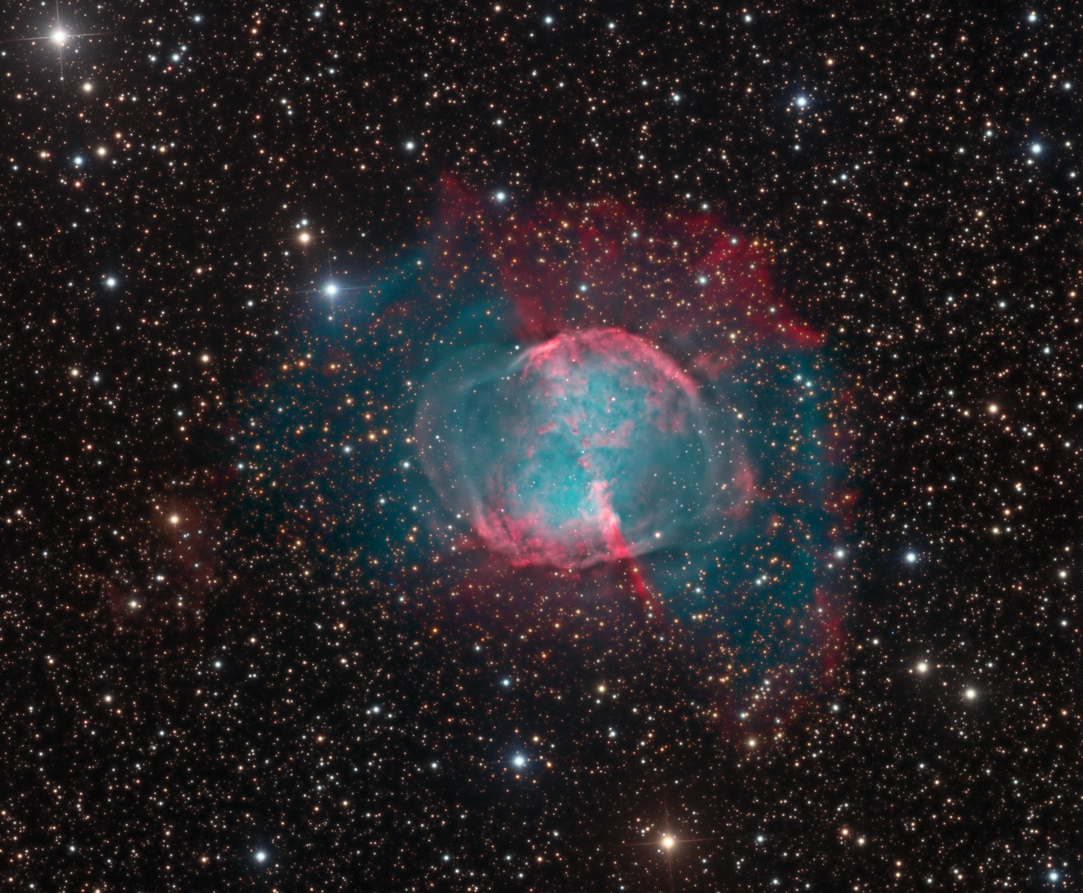M27: Stars with mass similar to that of our Sun throw off their outer gasses after fusion has stopped in their core, with the remaining star collapsing to become a white
dwarf (which will have a mass similar to our sun, and a diameter similar to earth--it's very dense!). The tiny blue star at the center of the nebula is the star that created this marvelous display
(yes, a "white dwarf" may not be white). Nebulae of this type are called "planetary nebulae," because in older smaller scopes, some looked like small, blurry planets. M27 is one of the most famous,
and easily found, of these "planetary nebulae." M27 is about 1200 light years from Earth, visually in the constellation Vulpecula, high in the summer sky in the norther hemisphere.
At that distance, the full nebula in my photo has a diameter of about 5 light years.
M27 is quite bright (magnitude 7.5), an easy visual object for even a modest telescope (or binoculars), and looks like a fat, ghostly hourglass (no color shows through any telescope through which I have
observed M27; I'm guessing that what I see as an hourglass someone else saw as weight-lifting dumbbells). It is a challenge to photograph effectively, since the inner structure is much, much brighter
than the halo around the bright part of the nebula, making it difficult to show the halo without having the inner part overexposed.
It is estimated that M27 is about 10,000 years old; it is remarkable to consider that, in those 10,000 years, the forces of the destruction of that star have pushed matter that had been part of the star
to being a couple of light years from the center of the star (and it's still expanding).
I have imaged this target previously; most recently 18 years before I took this version, with fairly elemental equipment (at least by comparison). I have always liked that version,
but I wanted to see what I could capture of the very faint halo; if you want to compare the versions, click here.
Technical Information:
HaOIIISIILRGB: 660:780:600:465:180:180:240 (almost 52 hours of images; L, R and G individual images were all 15-minute exposures; B images were 20 minutes each, and Ha, OIII and
SII were 30-minute individual exposures). All images were unbinned. The luminance layer has data from the Ha, OIII and SII woven into the L data; the red channel has Ha and SII woven into the R data,
and the green and blue channels include OIII data. The pink regions are Ha emissions (with significant SII emissions in the core part of the nebula!, and taking exposures through an Ha filter helps
bring out that color; the bluish regions are characteristic of OIII emissions, and taking images through an OIII filter helps bring out that color. The outer halo is a mix of Ha and OIII emissions
(and probably some other emissions).
Equipment: RC Optical Systems 14.5 inch Ritchey-Chrétien carbon fiber truss telescope, with ion-milled optics and RCOS field flattener, at about f/9, and an
SBIG STX-16803 monochrome camera with internal filter wheel (SBIG filter set), guided by an SBIG AO-X, all riding on a Bisque Paramount ME German Equatorial Mount.
Image Acquisition/Camera Control: Maxim DL, controlled with ACP Expert/Scheduler, working in concert with TheSky X Professional Edition.
Processing: All images calibrated (darks, bias and sky flats), aligned and combined in Pixinsight. RGB Color combine in Pixinsight. Weaving of narrow-band data into the broadband data
done in Pixinsight. Some finish work (background neutralization, color calibration, HDR Mulitscale Transform and Multiscale Linear Transform--for both noise reduction and wavelet sharpening--of luminance
data) done in Pixinsight; LRGB combination and some further finish work was done in Photoshop CC.
Location: Data acquired remotely with my equipment hosted by Sierra Remote Observatories, Auberry, California, USA.
Date: Images taken on many nights in August, 2021. Image posted September 27, 2021.
Date: Image scale of full-resolution image: 0.56 arcseconds per pixel.
Seeing: Generally excellent, with individual calibrated luminance frames varying from 1.5 to 1.8 arcsecond FWHM.
CCD Chip temperature: -25C
Copyright 2021 Mark de Regt

